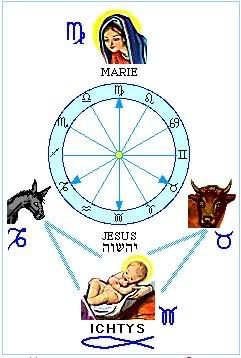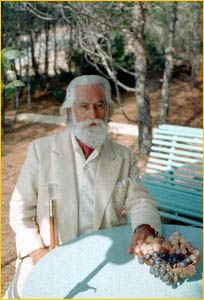|
The 4 Cardinal Festivals
Omraam Mikhael Aivanhov 2007.10.31. 14:37
 Christmas, Easter, Johnmas and Michaelmas Christmas, Easter, Johnmas and Michaelmas
If there are four cardinal feasts or festivals: Christmas, Easter, Johnmas and Michaelmas, it is not accidentally or because it pleased some monks to establish them, but because they correspond each at particularly significant moments in the cycle of the year. During one year, the sun passes through four cardinal points: - in March 21, spring equinox (Easter);
- in June 21, summer solstice (Johnmas);
- in September 21, autumn equinox (Michaelmas);
- in December 21, winter solstice (Christmas).
During these four periods in the nature occur great influxes and traffics of energies which influence the earth as well as all the beings which populate her: plants, animals, human beings, etc. The passage from a season to the other one takes place at these four points which are extraordinary knots of definite force for every season. In these dates the sun sends particularly powerful forces from which one can benefit, if one is conscious, attentive, well prepared and in accordance with the cosmos. Christmas and Easter (the birth of Jesus which is celebrated in the beginning of winter, and his resurrection which is celebrated in the spring) represent two pages in the great Book of Nature. This idea may offend many Christians, but instead of being offended, they would do better to reflect on it. Those who fixed the dates of these feast days long ago were beings who possessed great knowledge of the relationship between nature and the human soul. They had meditated profoundly on the life of Jesus and his teaching and had understood that in his identification with the cosmic principle of the Christ, an ideal encounter had taken place in him between the spiritual life and the life of nature, the universal life. In an effort to distinguish itself as clearly as possible from paganism, which was characterized by the worship of the forces of nature, Christianity severed its living ties with the universe. This is why even today the profound meaning of their religion eludes Christians. Only a few initiates who possess the true science of symbols recognize in the birth and resurrection of Jesus processes which are linked to the cosmic life and thus have universal meaning.
Christmas - Birth |  The birth of Jesus was a historical event of vital significance, but if it was enough for Jesus to be born two thousand years ago, why has the Kingdom of God still not descended to earth? Wars, misfortune, disease, all these should have disappeared... The birth of Jesus was a historical event of vital significance, but if it was enough for Jesus to be born two thousand years ago, why has the Kingdom of God still not descended to earth? Wars, misfortune, disease, all these should have disappeared...
True disciples know that, on the night of Christmas, Christ was born into the world in the form of light, warmth and life, and they make the necessary preparations, setting up the right conditions, so that this divine Child may also be born within them. Yes, you can read the history of the birth of Jesus as many times as you like, and sing: "Unto us a divine Child is born", but so long as Christ is not born within you, all those will serve to nothing. So it is up to each of us to have this desire to allow Christ to be born in our soul and to become like Him so that the earth becomes populated with Christs. This is what Jesus sought when he said: "Very truely, I tell you, the one who believes in me, will also do the works that I do. And, in fact, he will do greater works than these..." - Well, where are these works, greater than those of Jesus? Go on, show them to me!... For some Christ has already been born and for some He will be born soon... What is important is the preparation, the setting-up of the right conditions. Christmas has three aspects or three dimensions: - Historic event: the birth of Jesus in Palestine,
- Cosmic aspect: the return of the sun or winter solstice (birth of light),
- Mystic dimension: the birth of Christ's principle into the human being.
"For to them God would make known what are the riches of the glory of this mystery among the nations, which is Christ in you, the hope of glory, whom we preach, warning every man and teaching every man in all wisdom, so that we may present every man perfect in Christ Jesus." (Colossians 1:27-28) During the period of flourish or revival of Christmas and New Year (birth of the new year) there is the feast of St-John (December 28). Gabriel, who means "Hero of God" or "Man of God", is the archangel of the annonciation. He dominates winter and Christmas. |
Symbolism of the crib of Christmas  Correspondances of the crib of Christmas with the signs of zodiac, that represent a scene of our internal life. Correspondances of the crib of Christmas with the signs of zodiac, that represent a scene of our internal life. « Each year, on December 25, Christians celebrate the birth of Jesus, and in all the churches a crib is set up for him. The child is there lying on a pile of straw while Mary and Joseph watch over him, but there is also an ass and an ox. We can never forget the ass and the ox - they are so closely linked to the birth of Jesus. Why? Because this representation is symbolic and corresponds to some processes that take place in human beings. The stable represents the physical body. The ox represents sexual energy. As for the ass, it represents what we call "the old Adam", a self-centered, headstrong and stubborn but good servant. When man decides to improve himself so that Christ may be born within him, he comes in conflict with the forces of his lower nature and his sexuality. It is these forces that he must master and put to work for the divine child. That is why we say that, in the stable, the ass and the ox breathed on the child Jesus and warmed him with their breath... When human beings succeed in transforming within themselves the ass and the ox, then they can warm and nourish the newborn child. All those who have succeeded in bringing Christ to birth within themselves will be served by the forces of their lower nature and their sexuality, for these are extraordinarily useful energies, provided we can harness them to a job. » « What do we celebrate at Christmas? The union of the soul and spirit. They unite to give birth to a seed which is the beginning of a new consciousness within us. This consciousness manifests as an inner light that dispels all darkness... as heat of such intensity that, even if the whole world abandons us, we never feel alone... as an abundant life that bursts forth wherever our feet take us. This consciousness is also accompanied by an influx of forces that we wish to consecrate to the edification and construction of the Kingdom of God, and at the same time by the extraordinary joy of feeling ourselves to be part of this immensity, linked to the whole universe and to all evolved souls. And finally, we are certain that no one can take this joy from us. In India, this state is called buddhic consciousness, and the Christians call it the birth of Christ. » Omraam Mikhael Aivanhov

|

